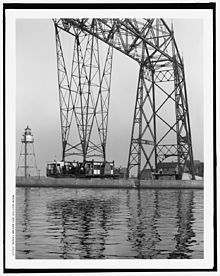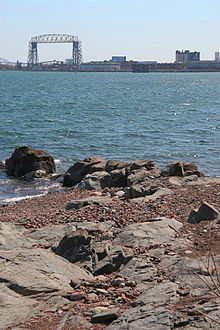The Aerial Lift Bridge (earlier known as the Aerial Bridge or Aerial Ferry Bridge) is a major landmark in the port city of Duluth, Minnesota. The span began life as an extremely rare transporter bridge — the first of just two such bridges ever constructed in theUnited States.[2] Originally built in 1905, the bridge was upgraded in 1929–30 to a vertical lift bridge, which is rather uncommon, (although there are six such bridges along Ontario's Welland Canal), and continues to operate today. The bridge was added to theNational Register of Historic Places on May 22, 1973. A maritime museum maintained by the United States Army Corps of Engineersexists near the site of the bridge.
Bridge history
The bridge spans the Duluth Ship Canal, which was put through the thin but long sand spit named Minnesota Point (commonly referred to as Park Point by locals) in 1870–71. The natural mouth of the Saint Louis River is about seven miles (11 km) farther southeast, and is split between Minnesota and Wisconsin. Creating this gap in the tiny peninsula meant that residents who lived on the new island needed to have a way to get across. Several different transportation methods were tried, though they were complicated by the weather. Ferries could work in the summer, but ice caused problems in colder months. A swinging footbridge was used, but was considered rather rickety and unsafe.
In 1892, a contest was held to find a solution. The winning design came from John Low Waddell, who drew up plans for a high-rise vertical lift bridge. The city of Duluth was eager to build the bridge, which would have been about 130 feet (40 m) wide. However, the War Department objected to the design, and the project was canceled before it could be built. Waddell's design went on to be built in Chicago, Illinois as the slightly larger South Halsted Street Bridge (removed in 1932).[3][4][5]
New plans were later drawn up for a structure that would ferry people from one side to the other. This type of span, which is known variously as an aerial transfer, ferry, or transporter bridge, was first demonstrated in Bilbao's Vizcaya Bridge in 1893 and one in France in 1898. Duluth's bridge was inspired by the one in France, though the actual construction is quite different. The architect was a city engineer, Thomas McGilvray.[1]
When it was completed in 1905, the Aerial Bridge's gondola had a capacity of 60 short tons (54tonne) and could carry 350 people plus wagons, streetcars or automobiles. A trip across the canal took about one minute, and the ferry car moved across once every five minutes during busy times of the day.[6] A growing population on Minnesota Point, a greater demand for cars, and an increase in tourism soon meant that the bridge's capacity was being stretched to the limit.
A remodeling was planned that would remove the gondola and incorporate a lifting platform into the structure. The firm finally commissioned with designing the new bridge was the descendant of Waddell's company. The new design, which closely resembles the 1892 concept, is attributed to C.A.P. Turner. Reconstruction began in 1929.[1] In order to ensure that tall ships could still pass under the bridge, the top span had to be raised to accommodate the new deck when raised. The support columns on either side were also modified so that they could hold new counterweights to balance the weight of the lifting portion. The new bridge first lifted for a vessel on March 29, 1930.[6]
The bridge can be raised to its full height of 135 feet in about a minute, and is raised approximately five thousand times per year.[7] The span is about 390 feet (120 meters). As ships pass, there is a customary horn-blowing sequence that is copied back. The bridge's "horn" is actually made up of two Westinghouse Airbrake locomotive horns.[8] Long-short-long-short means to raise the bridge, and Long-short-short is a friendly salute.
BLUEJEW BROUGHT TO YOU BI:
HOME OF THE:
COMING UP NEXT :)






















0 comments:
Post a Comment